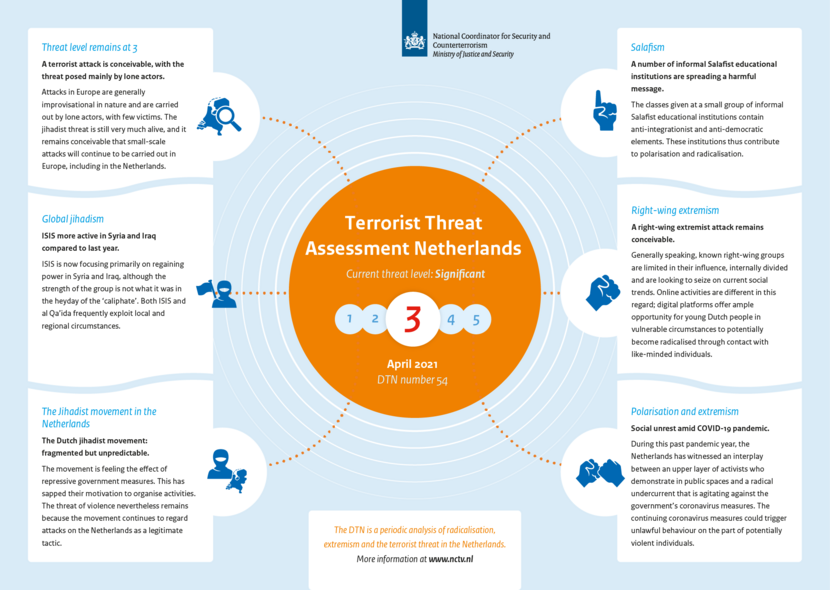NCTV Terrorist Threat Assessment: an attack in the Netherlands is conceivable, but there are no indications that one is being prepared.
At present, there are individuals in the Netherlands who are becoming radicalised or who are already highly radicalised and could pose a threat to national security. There are currently no indications that individuals in the Netherlands are preparing attacks, though it is conceivable that a lone actor could decide to commit an act of violence. In the past few years, attacks in Europe were mainly carried out by lone jihadists or Islamists whose extremist ideology was often accompanied by psychosocial or psychiatric problems. The attacks in France and Austria in the autumn of 2020 illustrate the kind of threat that lone actors can pose. For this reason the threat level has been maintained at 3 (on a scale of 1 to 5). These are some of the key conclusions of the 54th edition of the Terrorist Threat Assessment for the Netherlands, published by the National Coordinator for Counterterrorism and Security (NCTV).
The Dutch jihadist movement
The Dutch jihadist movement still constitutes the principal terrorist threat to the Netherlands. In 2020, this threat seems to have declined somewhat in comparison to previous years, however. In the Netherlands this movement is both socially and ideologically fragmented, and lacks charismatic leadership and a strong, hierarchical structure. As the NCTV explains in its latest report, the impact of repressive measures by the government has weakened the movement’s motivation to organise activities. The threat of violence nevertheless remains because the movement continues to regard attacks on the Netherlands as a legitimate tactic. This threat could increase due to various factors, such as the release of prisoners currently held in special terrorist wings, the return of jihadist travellers or external developments, both at home and abroad. The next few years will be decisive for the jihadist movement: if it continues to disintegrate, this could cause the movement to shrink and lead to a less receptive environment for jihadists re-entering society after imprisonment.
A number of informal Salafist educational institutions are spreading a harmful message
Salafist centres in the Netherlands regularly offer informal classes. The classes preach intolerance, exclusion, hate and rejection of those with dissenting views and of members of other faiths. The NCTV finds this particularly alarming when this message is being delivered to children and other vulnerable groups. Over the long term this intolerant, isolationist style of teaching could undermine the ‘vertical’ dimension of the democratic legal order (the relationship between citizens and the government). Although Salafists are only a small minority within the Muslim community, other forms of Islam lag behind in terms of the instructional content they provide. This means that Salafism is able to exert a disproportionate influence on the Muslim community.
Right-wing extremism
Troubled young people in the Netherlands can be particularly attracted to the growing international online right-wing extremist scene which, in the Netherlands, consists of a small-scale collection of private groups. It is conceivable that a lone right-wing extremist in the Netherlands could carry out an attack. In addition there are people in right-wing extremist (and anti-government) circles who have made online threats of serious violence. At the same time, the NCTV notes that these threats are not concrete in nature.
Social unrest amid COVID-19 pandemic
This edition of the DTN is accompanied by a phenomenon analysis of the coronavirus protests, in which the NCTV, in coordination with the National Police and the General Intelligence and Security Service (AIVD), concludes that there were relatively few instances of conduct in the past year’s protests that could be qualified as extremist. Nevertheless concerns remain. During this pandemic year, the Netherlands has witnessed an interplay between an upper layer of activists who demonstrate in public spaces and a radical undercurrent that is agitating against the government’s coronavirus measures. This has given rise to a situation in which the threshold for engaging in extremist behaviour has been lowered. The continuing coronavirus measures could trigger unlawful behaviour on the part of potentially violent individuals. At present such behaviour mainly takes the form of public order disturbances.
